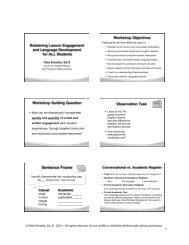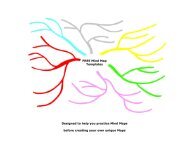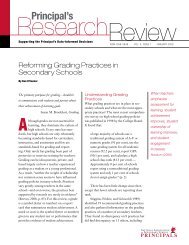Guidelines for Image Selection for Beginning Viewers - eStaffRoom
Guidelines for Image Selection for Beginning Viewers - eStaffRoom
Guidelines for Image Selection for Beginning Viewers - eStaffRoom
You also want an ePaper? Increase the reach of your titles
YUMPU automatically turns print PDFs into web optimized ePapers that Google loves.
<strong>Guidelines</strong> <strong>for</strong> <strong>Image</strong> <strong>Selection</strong> <strong>for</strong> <strong>Beginning</strong> <strong>Viewers</strong>, © 1998<br />
Artistic genre<br />
Various categories of art (land-, sea- and town/city-scapes,<br />
portraiture/self portraits) should each be given some attention, although<br />
“genre” scenes will dominate <strong>for</strong> beginner viewers. It is not assumed that<br />
viewers will acknowledge or even appreciate this diversity. However, if they are<br />
continuously being exposed to a range of in<strong>for</strong>mation, the groundwork will be<br />
there <strong>for</strong> conscious awareness and appreciation later.<br />
Key artists and works<br />
Artists in whom some collective pride is taken should be represented, as<br />
well as works that are particularly well known. Decisions of this kind are not<br />
particularly important to the viewer, but they help legitimize this approach to<br />
teaching to those more familiar with art than with the needs of beginning<br />
viewers--and they also help the student in learning the canons of art history if<br />
and when s/he becomes interested in doing so.<br />
Sequences<br />
Once a selection is made, putting the images in a sequence leading from<br />
ones that are simpler (where there are clearer and fewer possible meanings,<br />
fewer details, less density of content) and working toward more complex ones<br />
(where there is greater ambiguity of meaning, where ferreting out signifying<br />
details is more time consuming, where more of the meaning is communicated<br />
through style and materials than through iconography or subject, where<br />
symbolism and metaphor are more important). The number of images depends<br />
on the age and experience of the group, as well as its size, but considering that a<br />
good discussion takes from 12 to 20 minutes <strong>for</strong> a group of 20-25, somewhere<br />
between three and five images is a good number to plan <strong>for</strong> a single lesson, in a<br />
museum or out.<br />
Some thoughts on what might be avoided<br />
At beginner levels, it is important to avoid introducing art work that<br />
requires specialized in<strong>for</strong>mation in order to find meanings intended by the artist<br />
or culture. If a group cannot come up with a reasonably accurate interpretation<br />
of an object--as in the case of a symbol-laden representation of the Hindu god<br />
Siva, perhaps--then wait to introduce it. There will come a point when seeking<br />
in<strong>for</strong>mation is itself an intriguing pursuit. Historical, religious and mythological<br />
subjects, and ethnic-specific should be avoided because of their specificity: there<br />
are "correct answers," and misinterpretations can be misleading and intellectually<br />
specious. But again, there are many cases where the art object tells a story that<br />
makes sense even if certain particulars are not surmised or understood in detail.<br />
A single African ancestor figure may be inscrutable, but an African mother and<br />
child may communicate clearly its meaning, and even its magic.<br />
Illustrations, most photojournalism, cartoons and advertisements are<br />
seldom productive as images <strong>for</strong> beginning viewers because they allow <strong>for</strong> only<br />
one, or at best a narrow range, of interpretations.<br />
In general, certain subjects should be avoided, not because they are<br />
unimportant nor because under some circumstances they might not be discussed<br />
Visual Understanding in Education • 119 West 23 rd Street, Suite 905 • NY, NY 10011 • 212 253 9007 6






